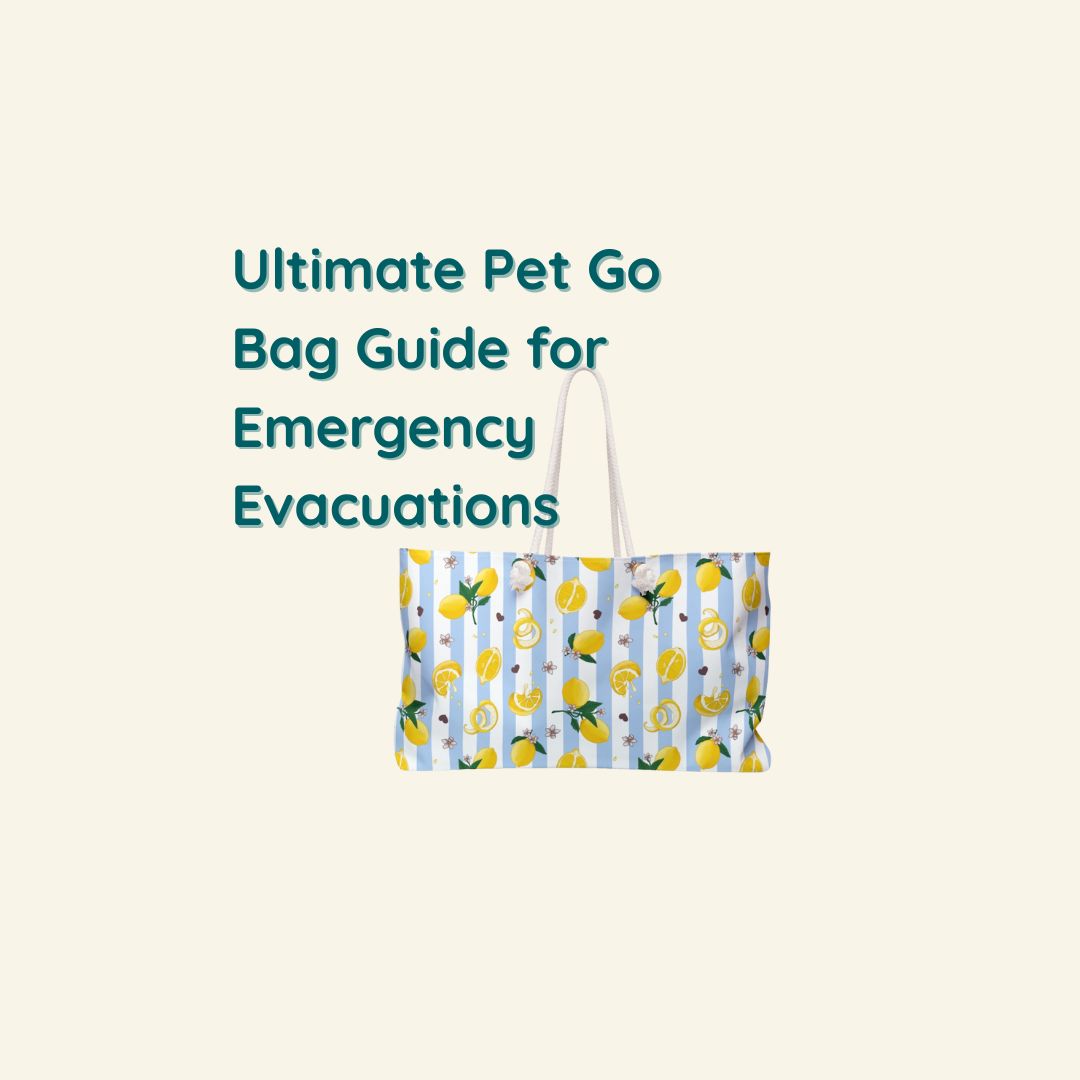
Ultimate Pet Go Bag Guide for Emergency Evacuations
Share
Imagine waking in the middle of the night to the urgent sound of your dog barking fiercely. You have only minutes to gather your thoughts and act before you must evacuate. In those critical moments, having a clear, practiced emergency evacuation plan is crucial. This plan should include knowing your evacuation routes and a designated meeting place. Equally important is having a pre-packed pet go bag ready to grab at a moment’s notice. This bag contains all the essentials your pet needs—food, water, medications, identification, and comforting items—to keep them safe and calm amid chaos.
Recent disasters—from the Texas floods to the devastating LA wildfires or even the ones on Maui—remind us that evacuations often come with little warning. And times of disaster are not the time to try and think about packing. Having a well-prepared evacuation plan combined with a pet go bag isn’t just practical; it’s a profound act of love and responsibility for every pet parent.
Why a Preplan Matters
-
Thousands of pets displaced: After major disasters, many animals end up separated from their families because pet parents didn’t have proper ID. Get your pet microchipped and it is strongly advised to keep a collar and ID tag on.
-
Expert recommendations: The ASPCA and other leading animal welfare organizations stress that a comprehensive pet emergency kit can be the difference between safety and heartbreak.
By preparing in advance, you ensure that no matter the crisis—flood, fire, earthquake—your furry, feathered, or scaled family member stays safe.
Building Your Pet Go Bag: Complete Checklist
Having a dedicated pet go bag is a cornerstone of any effective evacuation plan. This bag ensures that all your pet’s necessities are organized, accessible, and ready to go at a moment’s notice, reducing stress and saving valuable time during an emergency.
A robust go bag gives you peace of mind and your pet the essentials needed during an evacuation.
1. Food & Water
- 3–7 days’ supply of preferred pet food in airtight containers, or purchase a small bag of their regular food and keep it handy.
- Bottled water (minimum one gallon per pet per day)
- Manual can opener (if packing canned food)
- Collapsible bowls for feeding on the go, or just regular ones if collapsible aren't available or to save money.
- Treats including calming treats if your pet is anxious.
2. Medications & Veterinary Records
- Two weeks’ supply of all prescription medications
- Dosing instructions and dosage schedule
- Printed and digital copies of vaccination records and medical history stored in a fireproof pouch. Digitally online that you can access from any computer in case you do not have a computer or phone.
- Contact information for your veterinarian and emergency clinics
3. Identification & Photos
- Secure collar with up-to-date ID tags (phone number + out-of-area emergency contact)
- Microchip registration with current owner details
- Recent photos of your pet (digitally accessible from any computer) to create “Lost Pet” posters if needed
4. Leash, Harness & Carrier
- One sturdy carrier per pet, labeled with your contact information for smaller pets
- Leash and harness for each animal
- Comfort items inside carriers (blanket or familiar towel, and toys)
5. Sanitation & First Aid
- Waste bags, paper towels, and pet-safe cleaning wipes
- Litter and a disposable tray (for cats)
- Pet-specific first-aid kit and an easy-to-follow guidebook
Step-By-Step Evacuation Plan
A well-structured evacuation plan is essential to ensure both you and your pet stay safe during an emergency. Central to this plan is your pet go bag, packed and ready to go, so you can move quickly and confidently through each phase of evacuation.
Phase 1: Planning
- Map out exit routes from home and neighborhood
- Identify pet-friendly shelters, hotels, or boarding facilities in advance
- Place a window sticker alert so first responders know pets are inside, this is in case you are not there when a fire or evacuation occurs.
Phase 2: Gathering
- Quickly grab your pre-packed pet go bag, complete with important paperwork to ensure you have everything your pet needs for the journey ahead.
Phase 3: Evacuating
- Load pets calmly into carriers, using treats and soothing tones
- Carry emergency alert wallet cards to signal first responders if you become incapacitated
Phase 4: Reunification & Care
- Secure temporary lodging and check your pet’s physical and emotional health
Reducing Pet Stress During an Emergency
- Practice runs: Load carriers monthly so pets associate them with calm, familiar routines.
- Familiar scents: Include a worn shirt or a favorite blanket.
- Calming aids: Use pheromone sprays, calming treats or vet-approved supplements when necessary.
- Maintain routines: Feed and walk pets at their usual times, even in a new environment.
Emergency Alert Cards & Window Stickers
In chaotic moments, communication matters:
-
Wallet-Sized Alert Cards:
Keep these in your wallet to inform first responders that pets are at home or in transit—especially if you’re unable to speak for them. -
Weatherproof Window Stickers:
Place on home windows or vehicle windshields to signal neighbors and rescue teams that animals are inside and may require assistance.
Benefits:
-
Instant visibility to first responders
- Clear, bold icons ensure quick recognition
- Durable, weatherproof materials for outdoor use
Ready to add these essentials?
- Order your Emergency Alert Wallet Cards
- Grab your Emergency Alert Window Stickers
Region-Specific Scenarios for extra precautions
Flood Zones
- Include water filtration tablets or a portable filter
- Store gear in waterproof, buoyant containers
Wildfire Areas
- Identify multiple evacuation routes away from fire paths
- Pack pet-friendly smoke-reduction masks and goggles
Earthquake-Prone Regions
- Secure heavy items on shelves and create safe carrier storage zones
- Use breakaway collars to prevent entanglement if debris falls
Preparing a pet go bag is more than a checklist—it’s an expression of love and commitment to your furry family members. Don’t wait until disaster strikes. Assemble your go bag now and add our emergency alert cards and window stickers for an extra layer of protection and peace of mind.
Don’t let a moment of panic become a moment too late—equip your pet go bag today!
